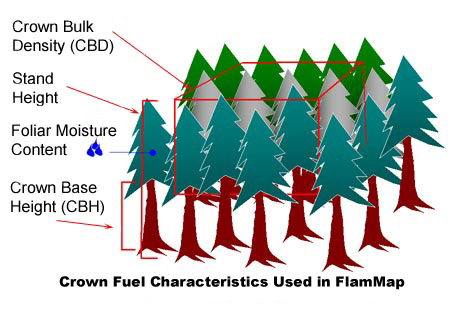
A surface fire may make the transition to some form of crown fire depending on the surface intensity and crown characteristics (Van Wagner 1977, 1993, Alexander 1988). The crown characteristics that are used to compute crown fire activity are;

After determining the surface spread characteristics, the fireline intensity is compared with the intensity threshold that is critical to involving the overlying crown fuels. If the threshold is met or exceeded, some form of crown fire has occurred. To determine what "type" of crown fire, active or passive (Van Wagner 1977), the equilibrium rate of crown fire spread is computed for the current spread direction (Rothermel 1991), modified by the "crown fraction burned" (Van Wagner 1993) and compared with the critical rate of spread required for an active crown fire. If this threshold is not met or is exceeded, the crown involvement is assumed limited to torching trees (a passive crown fire), else it becomes an active crown fire.
For passive (torching) crown fire the rate of spread (ROS) is determined by Crown Fire Calculation Method selected,
With both Crown Fire Calculation Methods active crown fire ROS is much higher than the surface fire ROS. The fireline intensity and flame length also increase significantly for active crown fire. More details on crown fire modeling can be found in Finney (2004), Scott (2006), and Scott and Reinhardt (2001).
|
Types of Wind Driven Crown Fire |
||
|
Passive or Torching |
Active |
Independent |
|
|
|
|
|
Low wind speed, low Crown Bulk Density & Cover, low Crown Base Height. |
Higher wind speed, high Crown Bulk Density & Canopy Cover, low Crown Base Height. |
Very high wind speed, very high Crown Bulk Density & Canopy Cover. |
There are two options for calculating crown fire behavior, the original FARSITE method described in Finney (2004) and the method described by Scott and Reinhardt (2001). Examples below attempt to show and explain the effects and differences between the two options. The examples utilize a central Idaho LandFire 40 fuel model landscape (v1.3.0), 90th percentile ERC-G live & dead fuel moistures, and moderate 8 mph 20-foot southwest winds. For the MTT runs Wind Ninja generated grids were utilized.
As expected the crown fire calculation method has no effect where only surface fire is simulated due to either lack of crown fuel data or where the critical intensity value for transition to crown fire is not reached. These results are presented to help the user understand the modelling methods rather than give specific distinctions between the crown fire calculation and propagation methods. Also be careful when comparing MTT results to the FARSITE results. While the landscape, initial fuel moistures, and simulation duration are identical remember the two modeling methods will have different weather, fuel moisture, and wind conditions.
The selected crown fire calculation method should take into consideration the landscape data source and its assumptions and limitations and how it can greatly impact modeling results. Furthermore, the effect of the selected crown fire calculation method should be considered through out the simulation process, even on landscape creation/modifications, spotting probability settings and simulation calibration. Simply changing the Crown Fire Calculation Method without considering all the inputs and modeling implications is a surefire way to get bizarre, inconsistent simulation outputs, and meaningless results.
More information can be found in Finney (2004), Scott and Reinhardt (2001), and Scott (2006).
FARSITE is a complex application, there are many interactions among the sub-models and the fire environment is constantly changing both temporally and spatially. In the image below timestep perimeters of two FARSITE simulations are shown, the white was using the Scott & Reinhardt method and the black shows the results with the Finney method. The red perimeter is the ignition.
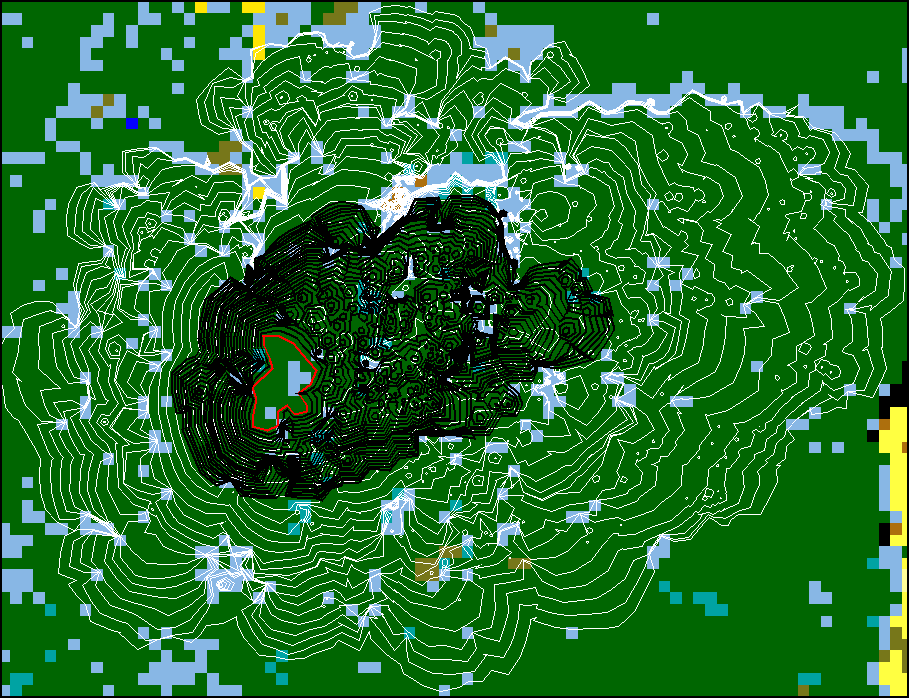
To better understand the differences in the two crown fire calculation methods below are two images of the Crown Fire Activity for both runs. Yellow cells are surface fire while the orange cells are passive crown fire (torching).
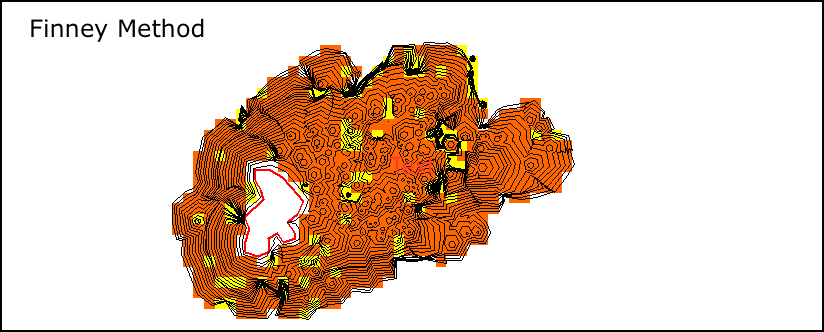
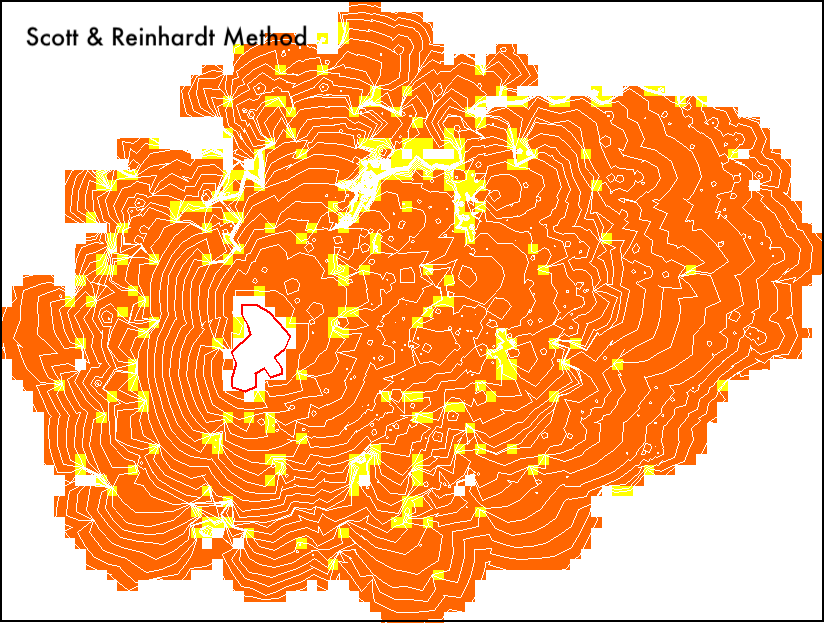
While the pattern of surface and passive crown fire activity are similar, the perimeters (look at the early ones) for the Scott & Reinhardt are much wider indicating a faster spread rate. This is expected as the Scott & Reinhardt method increases the surface ROS for passive crown fire activity while the Finney method does not. Because of the faster ROS FARSITE creates additional dynamic timesteps to meet the limits of the Distance Resolution. Since spots are also generated from each dynamic or sub time-step, additional spots are generated with the additional sub-timestep vertices.
Because the active crown fire ROS is reduced using the Finney method (see equation 23, Finney, 2004), the Scott & Reinhardt method will generate a faster active crown fire ROS. This in turn causes an increase in dynamic timesteps and thus increased spotting.
The Minimum Travel Time (MTT) fire growth method handles spotting differently from FARSITE, see the Spotting Technical Topic. MTT has a fixed number of nodes from which a fixed number of embers are launched where as FARSITE uses dynamic timesteps which can change the number of vertices from which embers are lofted. But still, as the image below shows, the two crown fire calculation methods can simulate vastly different MTT results under some common conditions.
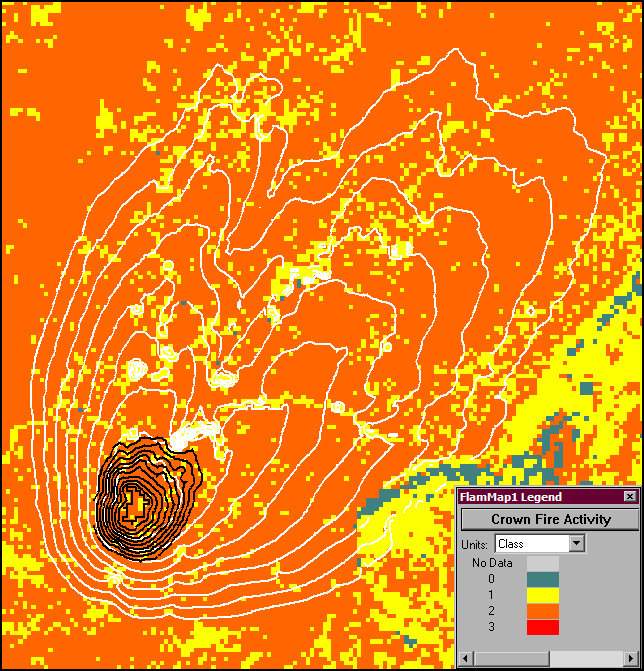
The MTT arrival time contour output using the Finney method are shown in black, while the Scott & Reinhardt contours contours are white. The background grid above is Crown Fire Activity, which unlike FARSITE is the same for both runs. Both contour intervals are the default 72 minutes (720 minutes duration/10). Both of these simulations have a similar number of spots, yet very different results.
Just like in FARSITE the Scott and Reinhardt method increases the Rate of Spread for nodes with passive crown fire. This can easily be seen in the example below.
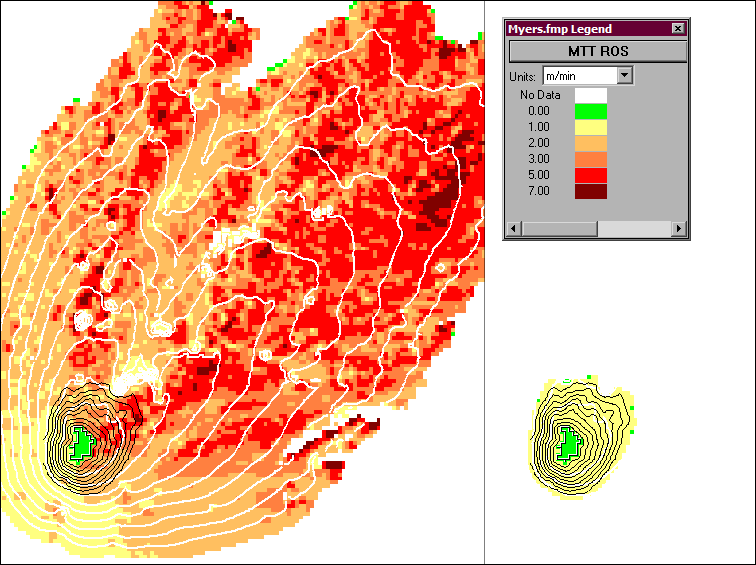
In these images of the MTT ROS outputs the Finney method, on the right, has MTT ROS values of 1 m/min or less while the Scott & Reinhardt output has significant nodes with 2, 3, 5, & 7 m/min rates of spread, even within the footprint of the Finney run.